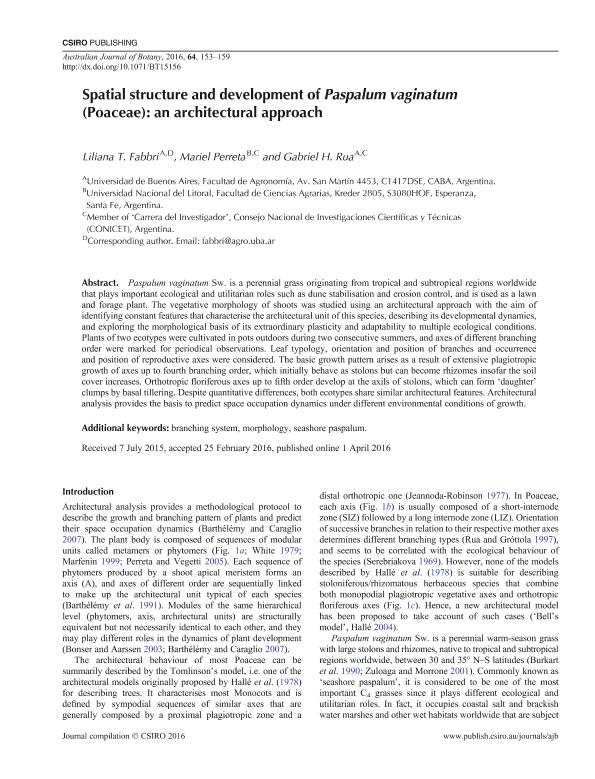Mostrar el registro sencillo del ítem
dc.contributor.author
Fabbri, Liliana Teresa

dc.contributor.author
Perreta, Mariel Gladis

dc.contributor.author
Rua, Gabriel Hugo

dc.date.available
2018-05-04T18:44:31Z
dc.date.issued
2016-03
dc.identifier.citation
Fabbri, Liliana Teresa; Perreta, Mariel Gladis; Rua, Gabriel Hugo; Spatial structure and development of Paspalum vaginatum (Poaceae): an architectural approach; Csiro Publishing; Australian Journal of Botany; 64; 2; 3-2016; 153-159
dc.identifier.issn
0067-1924
dc.identifier.uri
http://hdl.handle.net/11336/44199
dc.description.abstract
Paspalum vaginatum Sw. is a perennial grass from tropical and subtropical regions worldwide, that plays important ecological and utilitarian roles such as dune stabilization and erosion control, and is used as a lawn and forage plant. The vegetative morphology of shoots was studied using an architectural approach with the aim of identifying constant features that characterize the architectural unit of this species, describing its developmental dynamics, and exploring the morphological basis of its extraordinary plasticity and adaptability to multiple ecological conditions. Plants of two ecotypes were cultivated in pots outdoors during two consecutive summers, and axes of different branching order were marked for periodical observations. Leaf typology, orientation and position of branches, and occurrence and position of reproductive axes were considered. The basic growth pattern arises as a result of extensive plagiotropic growth of axes up to fourth branching order, which initially behaves as stolons but can become rhizomes insofar the soil cover increases. Orthotropic floriferous axes up to fifth order develop at the axils of stolons, which can form ´daugther´ clumps by basal tillering. Despite quantitative differences, both ecotypes share similar architectural features. Architectural analysis provides the basis to predict space occupation dynamics under different environmental conditions of growth.
dc.format
application/pdf
dc.language.iso
eng
dc.publisher
Csiro Publishing

dc.rights
info:eu-repo/semantics/openAccess
dc.rights.uri
https://creativecommons.org/licenses/by-nc-sa/2.5/ar/
dc.subject
Branching System
dc.subject
Morphology
dc.subject
Seashore Paspalum
dc.subject.classification
Otras Ciencias Biológicas

dc.subject.classification
Ciencias Biológicas

dc.subject.classification
CIENCIAS NATURALES Y EXACTAS

dc.title
Spatial structure and development of Paspalum vaginatum (Poaceae): an architectural approach
dc.type
info:eu-repo/semantics/article
dc.type
info:ar-repo/semantics/artículo
dc.type
info:eu-repo/semantics/publishedVersion
dc.date.updated
2018-04-27T18:53:15Z
dc.identifier.eissn
1444-9862
dc.journal.volume
64
dc.journal.number
2
dc.journal.pagination
153-159
dc.journal.pais
Australia

dc.journal.ciudad
Auckland
dc.description.fil
Fil: Fabbri, Liliana Teresa. Consejo Nacional de Investigaciones Científicas y Técnicas. Oficina de Coordinación Administrativa Parque Centenario; Argentina. Universidad de Buenos Aires. Facultad de Agronomía. Cátedra de Botánica General; Argentina
dc.description.fil
Fil: Perreta, Mariel Gladis. Consejo Nacional de Investigaciones Científicas y Técnicas. Oficina de Coordinación Administrativa Parque Centenario; Argentina. Universidad Nacional del Litoral. Facultad de Ciencias Agrarias. Cátedra de Morfología Vegetal; Argentina
dc.description.fil
Fil: Rua, Gabriel Hugo. Consejo Nacional de Investigaciones Científicas y Técnicas. Oficina de Coordinación Administrativa Parque Centenario; Argentina. Universidad de Buenos Aires. Facultad de Agronomía. Cátedra de Botánica General; Argentina
dc.journal.title
Australian Journal of Botany

dc.relation.alternativeid
info:eu-repo/semantics/altIdentifier/url/http://www.publish.csiro.au/bt/BT15156
dc.relation.alternativeid
info:eu-repo/semantics/altIdentifier/doi/http://dx.doi.org/10.1071/BT15156
Archivos asociados
